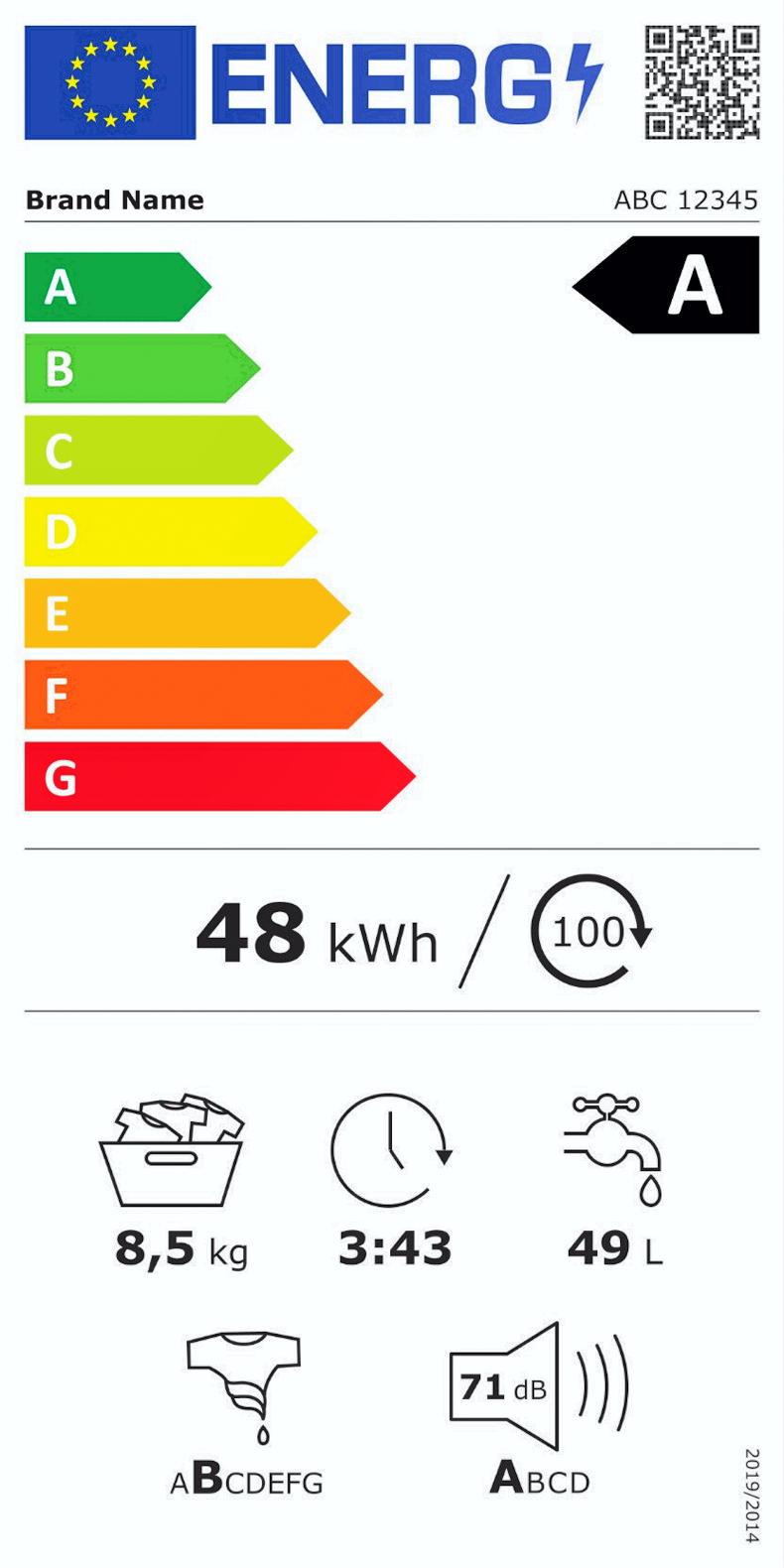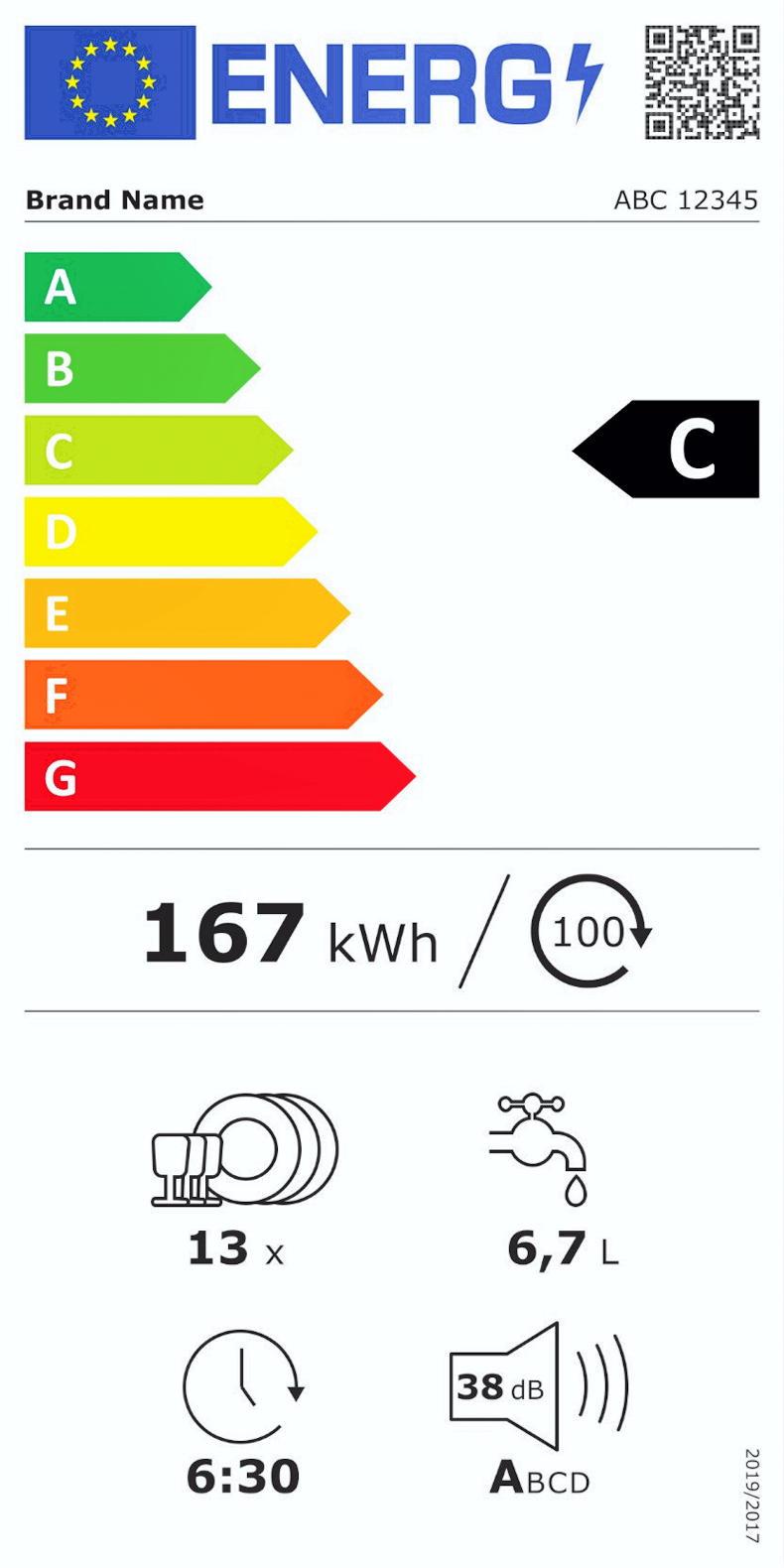If you’re planning on upgrading your fridge, or your washing machine has decided to give up the ghost, then new energy rating labels will greet you at the appliance shop.
Tim Stoke, programme manager with the Sustainable Energy Authority of Ireland (SEAI), explains the new system to Irish Country Living readers.
What is the new energy-rated labelling system?
The new energy labelling system is now an A to G system. You’re no longer going to see A+, A++ or A+++ on appliances. The A to G system is much more straightforward.

SEAI new energy labels.


Why are these changes being made?
Energy labels were introduced in the ’90s and initially the labelling system was A to G. This system was very successful for many years, especially as it encouraged manufacturers to develop much more energy-efficient products.
They all wanted to have A-rated appliances. However, over time, because so many manufacturers pushed their way to the top into the A bracket, they then needed differentiation in the top tier. This led to the introduction of A+, A++ etc in 2010.
While it was needed at the time, there was a fundamental flaw to this new system. Because so many were in the A category, some consumers would see A and think it was good, but the reality is you have to buy A+++ for the most energy-efficient appliance. It was a difficult system for consumers to actually work out.
So now, the European Union has changed the system again whereby the A+ categories are now gone and it is a straightforward A to G.
The new label recalibrates the scale, allowing for greater transparency and clarity and will make it easier for customers to choose the most energy-efficient product within their budget range.
I bought an appliance in January that was A-rated but now I see on the new system it is a G. Why is this?
All rescaled products will have a lower energy efficiency class than before. While this can be frustrating for consumers, it’s important to note that the energy efficiency of the product hasn’t changed, its just the labelling of it.
Consumers are going to find that there are a lot less A-rated appliances on the market now. It is a lot more difficult for a manufacturer to get an A grading, a lot more boxes that need to be ticked. But this is a good thing for consumers. They will know that if they decide to buy an A-rated appliance it is top of the range and very energy efficient.
With a new system in place, isn’t is possible that manufacturers will get ahead of the game, innovate their product to get into the higher energy rated brackets and we’ll be back in the same position in another 10 years, with a lot of appliances back in a the A category?
Because it is a lot harder for manufacturers to get an A rating, there is now a lot more room at the top to allow for innovation. This will help prevent that ‘bunching at the top’ scenario that we had in the past. But also, this scenario has been taken into consideration and this new system now has a review built it. So, from a consumer point of view, the A to G scale will stay in place, but behind the scenes, the parameters for manufacturers to get into the higher tiers may change to encourage continual innovation.
I went to my local appliance store recently and I saw that the A+++ symbol was still on the lighting fixture on display.
Yes, this new system is in place since 1 March, but not on all appliances at the moment. It is a phasing-in system. The new A to G system has been applied first to the appliances that really needed that differentiation – so household refrigerators and freezers, washing machines and washer dryers, dishwashers, TVs and electronic displays are the first products to carry the new label. Other products like lighting bulbs, domestic ovens and tumble dryers will gradually adopt the new labels between now and June 2022.
I saw an A+++ rating on a washing machine though. Should that not have a new label?
There is an exception to the rule and that is on products that have been discontinued. These models can stay on sale until the end of November. Just because it has an old label doesn’t necessarily mean that it is not energy efficient. Manufacturers update their models all the time and sometimes with very small amendments.
The washing machine that you saw, for example, may be discontinued because the manufacturer made a very simple amendment, such as changing the trim around the door to make it more energy efficient. In fact, because these models cannot be sold after the end of November, you may find there are great bargains to be had towards the end of the year as retailers try to shift this stock.
What other new information will be on the appliance label?
All appliances with the new labelling system now have a QR code, which you can scan on your phone. This will link you to a European database that provides information on other performance and environmental information, such as a product’s noise emissions and water consumption. It’s handy, for example, if you want a washing machine that doesn’t make a lot of noise or a fridge that has a large capacity – it makes it easier to compare one model against another. Again, it’s about making everything transparent for the consumer so it’s easier for them to make a decision when they’re buying a new home appliance.
For more information on the new EU energy label for electrical appliances please visit www.seai.ie.
If you’re planning on upgrading your fridge, or your washing machine has decided to give up the ghost, then new energy rating labels will greet you at the appliance shop.
Tim Stoke, programme manager with the Sustainable Energy Authority of Ireland (SEAI), explains the new system to Irish Country Living readers.
What is the new energy-rated labelling system?
The new energy labelling system is now an A to G system. You’re no longer going to see A+, A++ or A+++ on appliances. The A to G system is much more straightforward.

SEAI new energy labels.


Why are these changes being made?
Energy labels were introduced in the ’90s and initially the labelling system was A to G. This system was very successful for many years, especially as it encouraged manufacturers to develop much more energy-efficient products.
They all wanted to have A-rated appliances. However, over time, because so many manufacturers pushed their way to the top into the A bracket, they then needed differentiation in the top tier. This led to the introduction of A+, A++ etc in 2010.
While it was needed at the time, there was a fundamental flaw to this new system. Because so many were in the A category, some consumers would see A and think it was good, but the reality is you have to buy A+++ for the most energy-efficient appliance. It was a difficult system for consumers to actually work out.
So now, the European Union has changed the system again whereby the A+ categories are now gone and it is a straightforward A to G.
The new label recalibrates the scale, allowing for greater transparency and clarity and will make it easier for customers to choose the most energy-efficient product within their budget range.
I bought an appliance in January that was A-rated but now I see on the new system it is a G. Why is this?
All rescaled products will have a lower energy efficiency class than before. While this can be frustrating for consumers, it’s important to note that the energy efficiency of the product hasn’t changed, its just the labelling of it.
Consumers are going to find that there are a lot less A-rated appliances on the market now. It is a lot more difficult for a manufacturer to get an A grading, a lot more boxes that need to be ticked. But this is a good thing for consumers. They will know that if they decide to buy an A-rated appliance it is top of the range and very energy efficient.
With a new system in place, isn’t is possible that manufacturers will get ahead of the game, innovate their product to get into the higher energy rated brackets and we’ll be back in the same position in another 10 years, with a lot of appliances back in a the A category?
Because it is a lot harder for manufacturers to get an A rating, there is now a lot more room at the top to allow for innovation. This will help prevent that ‘bunching at the top’ scenario that we had in the past. But also, this scenario has been taken into consideration and this new system now has a review built it. So, from a consumer point of view, the A to G scale will stay in place, but behind the scenes, the parameters for manufacturers to get into the higher tiers may change to encourage continual innovation.
I went to my local appliance store recently and I saw that the A+++ symbol was still on the lighting fixture on display.
Yes, this new system is in place since 1 March, but not on all appliances at the moment. It is a phasing-in system. The new A to G system has been applied first to the appliances that really needed that differentiation – so household refrigerators and freezers, washing machines and washer dryers, dishwashers, TVs and electronic displays are the first products to carry the new label. Other products like lighting bulbs, domestic ovens and tumble dryers will gradually adopt the new labels between now and June 2022.
I saw an A+++ rating on a washing machine though. Should that not have a new label?
There is an exception to the rule and that is on products that have been discontinued. These models can stay on sale until the end of November. Just because it has an old label doesn’t necessarily mean that it is not energy efficient. Manufacturers update their models all the time and sometimes with very small amendments.
The washing machine that you saw, for example, may be discontinued because the manufacturer made a very simple amendment, such as changing the trim around the door to make it more energy efficient. In fact, because these models cannot be sold after the end of November, you may find there are great bargains to be had towards the end of the year as retailers try to shift this stock.
What other new information will be on the appliance label?
All appliances with the new labelling system now have a QR code, which you can scan on your phone. This will link you to a European database that provides information on other performance and environmental information, such as a product’s noise emissions and water consumption. It’s handy, for example, if you want a washing machine that doesn’t make a lot of noise or a fridge that has a large capacity – it makes it easier to compare one model against another. Again, it’s about making everything transparent for the consumer so it’s easier for them to make a decision when they’re buying a new home appliance.
For more information on the new EU energy label for electrical appliances please visit www.seai.ie.









 This is a subscriber-only article
This is a subscriber-only article











SHARING OPTIONS: